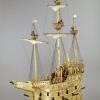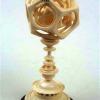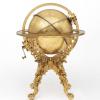August of Saxony by Lucas Cranach jr., 1572
Commentary
Elector Augustus I of Saxony, 1526-1586 (reigned 1553-1586)
Augustus was born into the Wettin dynasty of Saxony, a family that had protected Martin Luther and nurtured the Protestant Reformation. Augustus’ inheritance was therefore a Lutheran domain that existed within the religiously heterogeneous Holy Roman Empire, headed by the Catholic Habsburg dynasty.
As one of the seven prince-electors of the Empire and the ruler of one of its most prosperous states, Augustus was forced to reconcile his princely ambitions with a characteristically Central-European socio-political environment. While greater Renaissance princes sought wealth and glory by waging war on their neighbours, Augustus focused his attention on understanding and developing the sources of prosperity within his own dominions. Under his direction, the mining and metallurgical activity of the Erzgebirge (Ore Mountains) in Saxony’s southeast were revitalized, the territory’s forests were systematically developed and exploited, and the Saxony’s agricultural land – the normal basis of prosperity in a still agrarian society – experimented with more efficient methods of cultivation.
These wide-ranging social and economic reforms were complemented by the duke’s equal fascination with the latest technology and this gave a very distinctive feature to his activity as a collector. Many Renaissance princes collected to display wealth, status, and intellectual reach. Augustus was no exception, but his collecting activity was also shaped by particularly keen desire to master the latest technological developments, both intellectually and practically.
His early example of the state support of Wissenschaft (study) in pursuit of practical as well as intellectual and cultural aims was located within Dresden’s Residenzschloss, the primary seat of Saxony’s Elector. Here Augustus collected specialists from many fields to help conceive and execute projects that were simultaneously pragmatic and befitting of a prince. To form a clearer understanding of his domain, Augustus was both patron and practitioner of cartography, alchemy and agriculture, among many other pursuits. He also kept abreast of recent court innovations through a network of Central European princes, each of whom fostered their own intellectual vocations.
Augustus can be characterized as a prince whose participatory interest in the work of both the common and the exceptional man resulted in the elevation of craft values to an elite preoccupation. Such a radical reversal of humanist notions of the liberal and mechanical arts is embodied in his preserved Kunstkammer in Dresden, which displays a unique focus upon technology and craft.
Commentary. Andrew Biedermann (October 2021)



